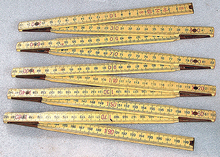Loading AI tools
Unit of length From Wikipedia, the free encyclopedia
A centimetre or centimeter (US/Philippine spelling), with SI symbol cm, is a unit of length in the International System of Units (SI) equal to one hundredth of a metre, centi being the SI prefix for a factor of 1/100.[1] Equivalently, there are 100 centimetres in 1 metre. The centimetre was the base unit of length in the now deprecated centimetre–gram–second (CGS) system of units.
| centimetre | |
|---|---|
 A carpenter's ruler with centimetre divisions | |
| General information | |
| Unit system | SI |
| Unit of | length |
| Symbol | cm |
| Conversions | |
| 1 cm in ... | ... is equal to ... |
| millimetres | 10 mm |
| imperial & US system | ~0.3937 in |

Though for many physical quantities, SI prefixes for factors of 103—like milli- and kilo-—are often preferred by technicians, the centimetre remains a practical unit of length for many everyday measurements; for instance, human height is commonly measured in centimetres.[2][3] A centimetre is approximately the width of the fingernail of an average adult person.
| 1 centimetre | = 10 millimetres |
| = 0.1 metres | |
| = 0.39370078740157477 inches (There are exactly 2.54 centimetres in one inch.) |
One millilitre is defined as one cubic centimetre, under the SI system of units.
In addition to its use in the measurement of length, the centimetre is used:
For the purposes of compatibility with Chinese, Japanese and Korean (CJK) characters, Unicode has symbols for:[6]
These characters are each equal in size to one Chinese character and are typically used only with East Asian, fixed-width CJK fonts.
Seamless Wikipedia browsing. On steroids.
Every time you click a link to Wikipedia, Wiktionary or Wikiquote in your browser's search results, it will show the modern Wikiwand interface.
Wikiwand extension is a five stars, simple, with minimum permission required to keep your browsing private, safe and transparent.